How Did The World Learn About Mali
Scholar-Griot: Rebecca Allyson Schnabel, M.S.
While knights rode around medieval Europe, the 3 great empires of West Africa prospered through unimaginable wealth. Ghana, Mali and Songhai controlled more aureate and conducted more global trade than any European power at this time in history.
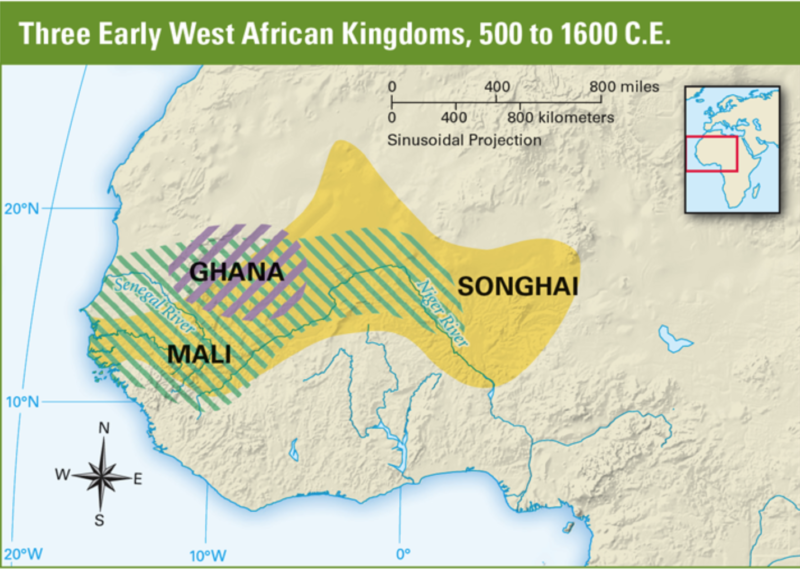
Three Early West African Empires
(Note: These celebrated empires are not the countries begetting the same names today. Also annotation: "CE" stands for "Common Era" and, similar "Advertising," measures the years as counted by Christian scholars from the birth of Jesus.)
Ghana (Wagadu) – 300 CE -1235 CE
Traditionally known as Wagadu, the empire of Ghana was the first of the great Western African Empires. Situated further northward than the modern-day Republic of Ghana, this was the smallest but longest surviving of these three historic domains. Located between two major rivers, the Niger and the Senegal, and bordered by the Sahara to the e, Ghana became the center of merchandise between the Arabs and Berbers in the northern regions and other African societies to the s. Bringing down salt from northern Africa, the Arabs and Berbers traded in Republic of ghana for gold and ivory.
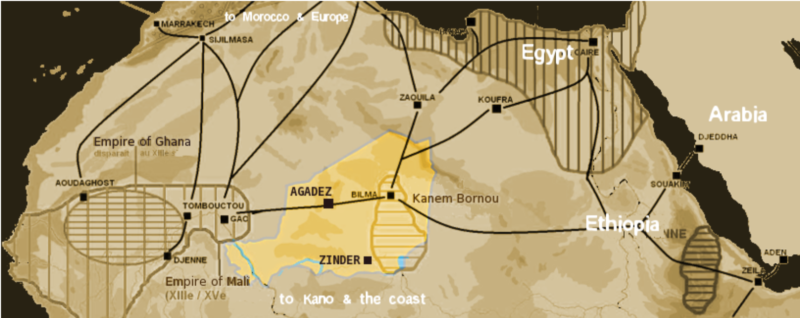
Empire of Ghana (Wagadu)
Ghana's wealth grew through a double taxation organization placed on their most valuable article, golden. People were taxed when bringing golden in and over again when taking it out of the empire. Ghana also profited from the exportation of gold. Aureate dust was the main currency of the time. Salt, still, is essential for human survival and rare the further south ones travels. Equally the want and need for further trade grew, the nomadic Berbers created the western trans-Saharan caravan road. Thanks to this intricate highway system, Mediterranean traders could travel due south to African strongholds like Ghana to exchange their common salt for ivory and gilded.
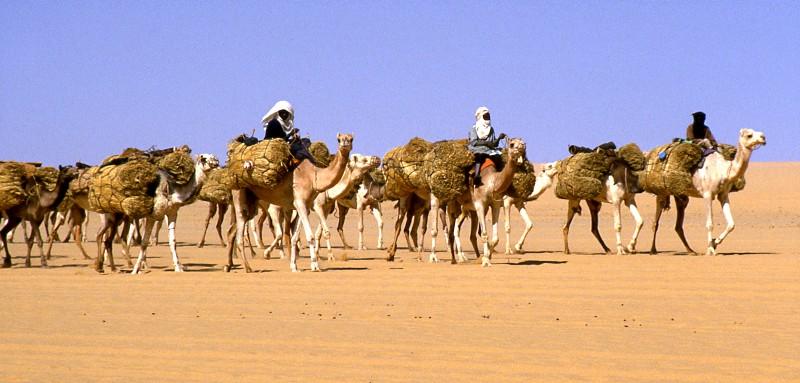
This 1985 Azalai salt caravan continues the tradition of trans-Saharan trade.
Leaders in Ghana, the Soninke, managed to keep their main source of gold, the Bambuk mines, a clandestine from the foreign traders. The Soninke kept the core of pure metallic for themselves, accumulating great wealth, and left the unworked native gold to exist marketed by the common people. Historians believe this international trade route mobilized hundreds of thousands of Africans, with the gold of Republic of ghana reaching far away European and Asian countries.
The disuse of this empires developed due to political turmoil from inside and invaders who penetrated Republic of ghana'south boarders and sacked their great cities. Scholars tell usa there were invasions from the North by groups like the Almoravids, equally well as by the short lived Sosso Kingdom. Sundiata Keita, founder of the Republic of mali empire, also took advantage of the weakness of Ghana. Irresolute trading routes played a major office in its decline besides, as did civil wars due to religious differences. Many people in Ghana rejected Islam, preferring their traditional belief systems.
For further readings on the political systems and major leaders of Ghana run into Historian Phillip Curtin's work titled African History, the Cambridge History of Africa, and the UNESCO series on the General History of Africa (GHA).
Republic of mali – 1230 CE – 1460 CE
Out of the ashes of Ghana came the next groovy civilisation of its fourth dimension –– and the richest kingdom ever to exist in world history — the Mali Empire. The roots of Mali start within ancient Ghana and the Malinke inhabitants of Kangaba, who served every bit middlemen trading aureate to foreigners. Sundiata Keita rose upward from his pocket-size kingdom of Kangaba, won the people'south support, conquered the last stronghold of Ancient Ghana, and began the reign of the Republic of mali Empire. His successors expanded the empire to envelope the trading towns of Timbuktu and Gao and northern regions such every bit Taghaza, containing the highly valuable salt deposits. Mali swallowed up the wealth of Ghana and expanded on their practices with cracking success.
In 1312 CE, Musa the Get-go or Mansa (meaning King or Emperor) Musa took the throne of Mali. He had an regular army of over 100,000 including a cavalry of more than x,000 men. This army was a formidable fighting force, which enabled Mansa Musa to double the size of his kingdom. He is remembered nigh notably as the richest human who ever lived.
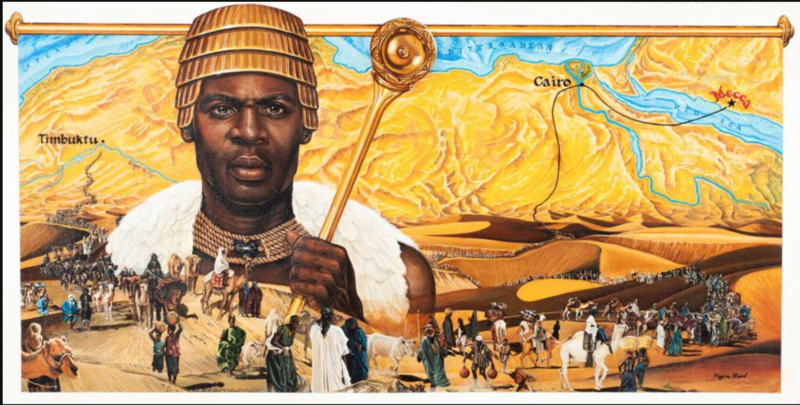
Mansa Musa, the richest man in history.
Ruling the gold center of the world, Mansa Musa'southward wealth is incomprehensible. Being a devout Muslim, Mansa Musa traveled across the continent and brought back scholars and architects. These experts would establish universities and mosques. His 4,000 mile pilgrimage to Mecca gave him the chance to evidence his generosity to the mutual people. Mansa Musa's gifts of aureate to mutual people throughout his hajj destabilized the entire Egyptian economy. His groovy generosity literally put him on the map. In 1375 Mansa Musa was portrayed on the Catalan Atlas, one of the most important world maps of Medieval Europe. He was depicted with a golden scepter and crown, seated upon a golden throne.
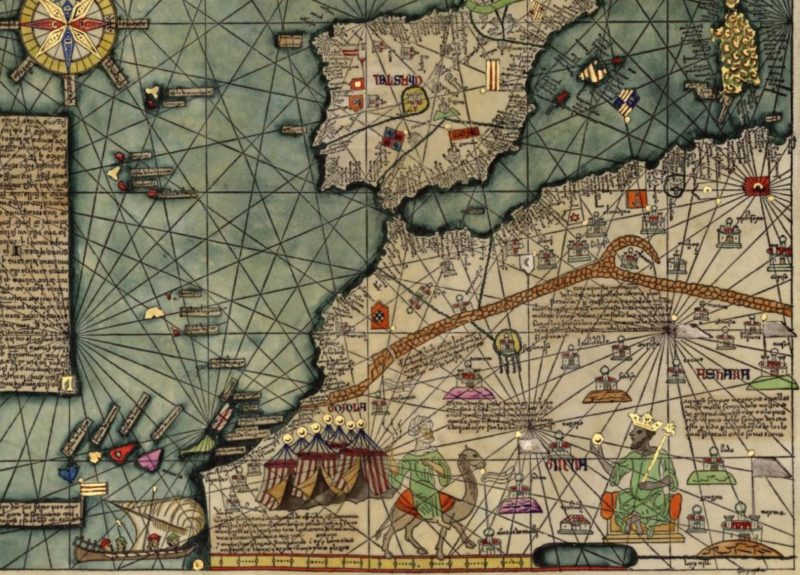
The Catalan Atlas was one of the virtually important earth maps of its day. Mansa Musa of Mali, as one of the world's about of import leaders, was pictured on information technology offer some of his gilded.
However, Mansa Musa contributed far more to the world than gilt. In an early on form of globalization, Mansa Musa sent ambassadors across the continent of Africa. In Mali he cultivated "a place of splendor, wealth, and sophistication," attracting European and Heart Eastern travelers alike. Mansa Musa also modernized the corking urban center of Timbuktu, edifice public schools, universities, and mosques. These include the legendary Djinguereber, the oldest mosque in Timbuktu, built in 1327, which nonetheless stands today. It holds 1 of the globe's oldest universities still in beingness.
Unfortunately, emperors who followed would lose command of several smaller states within Mali, causing disunity, revolt, and the erosion of fundamental power. As Republic of mali rose from the fall of Ghana, so Songhai would assert its independent power over the region, emerging as the next great Western African Empire.
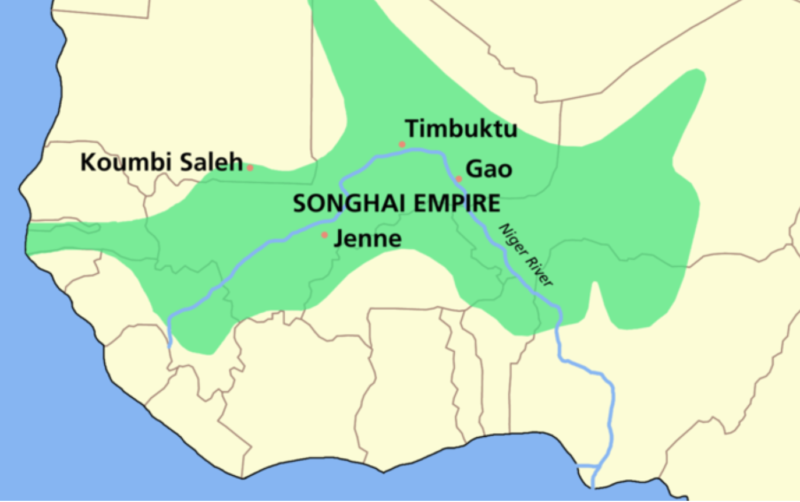
Songhai (also spelled Songhay) – 1460 CE – 1600 CE
While Republic of mali quickly vicious apart due to rampant disunity, a new king reigned. Sonni Ali ruled Songhai from 1464 to 1492. The Songhai kingdom was a pocket-size contemporary state of Republic of ghana but later rose to defeat its Malian conquerers. The Songhai controlled the merchandise on the Niger river at the time of the Mali Empire. Through countless campaigns for expansion, Songhai became the largest of the 3 smashing empires of Western Africa –– and larger than all of continental Europe. The Songhai kingdom under Ali had the only naval fleet in West Africa. Ali was a military tyrant, also referred to as Sunni the Merciless, intolerant of any resistance to his rule. He is known for having starved the citizens of renowned trading town of Djenné into submission. These vicious tactics explain how the empire grew so large in such a short amount of time, likewise suggesting why the empire would last just equally briefly. Sonni Ali is also known, still, for his wise economic decisions, reviving the aboriginal trade routes of empires by. Under his reign, vast commercial cities like Djenné, Gao, and Timbuktu became great centers of learning and scholarship.
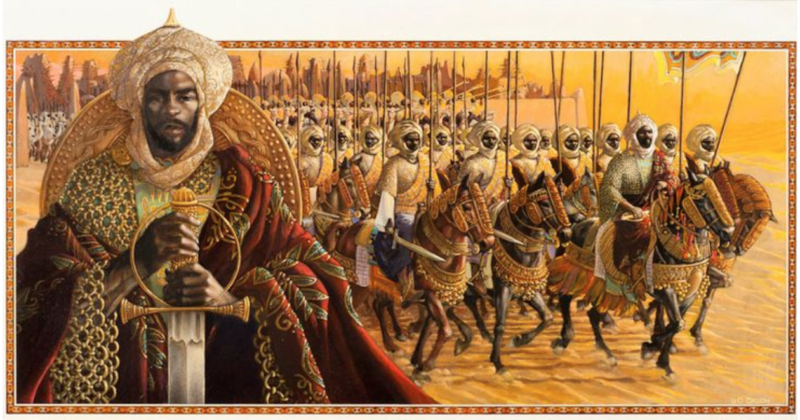
Rex Sonni Ali (as portrayed by the African Heritage Foundation)
Some other proficient ruler of the Songhai Empire was Askia the Slap-up. Known for encouraging international trade between Songhai and both Europe and Asia, Askia was besides known for his religious tolerance. Like the rulers before him of both Songhai and Mali, Askia the Great was a devout Muslim. He opened religious schools and mosques beyond the empire. Oral histories relate that he did not force Islam on his people or punish those who chose to believe otherwise. Simultaneously orchestrating a strategy of expansion and consolidation, Askia the Nifty did non form his domain forth traditional Islamic lines. He instead instituted a arrangement of bureaucratic government unparalleled at this time in Western Africa. The Songhai Empire possessed some of Africa's primeval organized taxation systems and trade regulations, continuing the ancestral trade routes of aureate, ivory, and salt. Amid Askia'due south well-known economic and military accomplishments is his less well-known interest in and influence on the evolution of the field of astronomy.
Past the 17thursday century satellite kingdoms along the borders began to rebel, and civil wars adult across the empire. The central power of the emperor also barbarous into constant strife as decedents fought over the right to rule. With the empire splintering apart from within, the neighboring region of Morocco decided to take advantage and launched an invasion. Despite having a tenth of the manpower, the Moroccan muskets far outperformed the traditional spears and arrows of the Songhai military. Moroccan leader Ahmad al-Mansur al-Dhahabi, known as 'the Golden Conqueror,' seized the Songhai treasure. He eventually absorbed all of the empire into a Moroccan province, dissolving the last of the Nifty Western African Empires.
In Decision
Like many historic empires, Ghana, Mali, and Songhai, did non survive into modern times. However, they were cardinal in shaping the world we live in today. Many European, Middle Eastern, and Asian strongholds would not have prospered without the trade from these African Empires. These African societies non but influenced the global economy, they also shaped the globe'southward fine art, culture, and religion through international trade. These empires provided protection and resources to many great African and Muslim scholars, thereby supporting the development of scientific discipline, philosophy, and other forms of noesis across the globe.
Sources
"Askia the Great: Revolt Leader to Powerful Songhai Emperor." Ancient Origins, Ancient Origins. April 28, 2019. www.ancient-origins.internet/history-important-events/askia-great-0011801.
Andrews, Evan. "7 Influential African Empires." History.com, A&E Television Networks. Januaray 11, 2017.
Cain, Áine. "Hither's What It Was similar to Exist Mansa Musa, Idea to Be the Richest Person in History." Concern Insider. February fourteen, 2018.
Cartwright, Mark. "Songhai Empire." Ancient History Encyclopedia. July 26, 2019.
"Plummet: Republic of mali and Songhai." Collapse: Why do civilizations autumn apart? Annenberg Foundation. 2016.
Department of the Arts of Africa, Oceania, and the Americas. "The Trans-Saharan Gold Merchandise (7th–14th Century Century)." In Heilbrunn Timeline of Art History. New York: The Metropolitan Museum of Art. October 2000.
Freado, Michael, director. The Neat W African Empires. July 21, 2016.
McLean, John. "World Civilization." Songhai | World Civilization. courses.
Morgan, Thad. "This 14th-Century African Emperor Remains the Richest Person in History." History.com, A&Due east Television Networks, 19 Mar. 2018
The Editors of Encyclopedia Britannica. "Ghana: Historical West African Empire." Encyclopedia Britannica. Last modified July ix, 2019.
The Editors of Encyclopedia Britannica. "Mali: Historical Empire, Africa." Encyclopedia Britannica. Concluding modified January 23, 2019. https://www.britannica.com/place/Mali-historical-empire-Africa.
The Editors of Encyclopedia Britannica. "Songhai: Historical Empire, Africa." Encyclopedia Britannica. Last modified April ii, 2019. https://www.britannica.com/place/Songhai-empire.
"The Story of Africa| BBC Globe Service." BBC News. .
"West African Kingdoms." TimeMaps. 2019.
Whistler, Hamza. "Kingdoms of the Grasslands – W African Kingdoms of Ghana, Mali, and Songhai Affiliate viii (2 of 4) - Ppt Video Online Download." SlidePlayer. 2015.
Rebecca Schnabel is a graduate of UW-Milwaukee's Masters of Public History and Museum Studies Certificate programs. She strives to cultivate a sense of community through engaging endeavors that connect history with the nowadays, particularly through empowering the general public to apply their own agency while exploring exhibitions on social justice. Rebecca'south passion does not reside in one specific historical era or geographic location, but instead in illuminating underrepresented histories. Her specialties include interpretation, collections direction, and exhibit design. To learn more than, please visit her online portfolio: https://schnabe4.wixsite.com/schnabel-portfolio.
How Did The World Learn About Mali,
Source: https://www.abhmuseum.org/three-of-the-worlds-most-influential-empires-wagadu-mali-and-songhai/
Posted by: capratheap1957.blogspot.com


0 Response to "How Did The World Learn About Mali"
Post a Comment